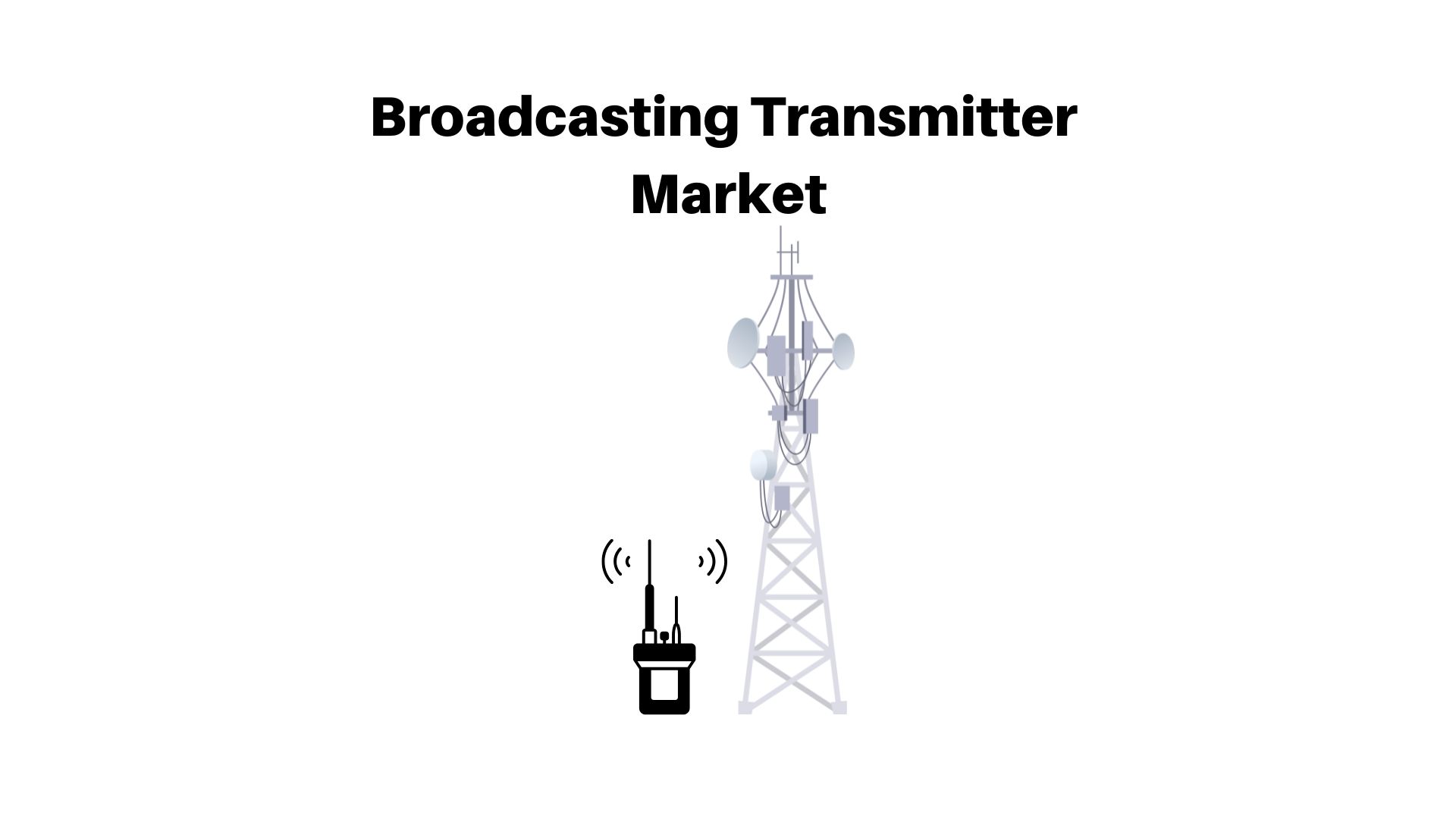Broadcasting Transmitter Market: (CAGR 9.12% )Technical Report + Feasibility Study, 2022-2032

Page Contents
Broadcasting Transmitter Market Overview
Published Via 11Press: The broadcasting transmitter market encompasses devices used to transmit radio or television signals over the airwaves. Broadcast transmitters enable radio and television broadcasters to reach audiences within their coverage areas.
The broadcasting transmitter market is being driven by an increasing need for high-quality broadcast services as well as more efficient and cost-effective transmission solutions. With the rise of digital broadcast technologies like DAB, DVB-T2, and ATSC 3.0, there has been an escalating need for transmitters that can support these new standards.
The global broadcasting transmitter market size is forecast to reach USD 2040.79 million by 2032 from USD 852.62 million in 2022, rising at a compound annual growth rate (CAGR) of 9.12% during the forecast period.
The market for broadcasting transmitters is also driven by regulatory factors, such as spectrum allocation and licensing requirements. Furthermore, technological developments like software-defined radio (SDR) development and the growing adoption of cloud-based broadcasting solutions have an effect on this sector too.
The broadcasting transmitter market is segmented based on type, frequency range, power output, and application. Types include FM, AM, DAB, DVB-T2, ATSC 3.0, and others while frequency ranges span VHF to UHF frequencies. Power outputs range from low to high with high coverage areas possible for some models; applications for these transmitters include radio broadcasting and television broadcasting among others.
Key players in the broadcasting transmitter market include Rohde & Schwarz, NEC Corporation, GatesAir, Hitachi Kokusai Electric Inc., and Eletec Broadcast. These companies offer a range of products and services, including transmitters, antennas, and broadcasting solutions.

Key Takeaways
- The broadcasting transmitter market is being driven by the growing need for high-quality broadcast services and cost-effective transmission solutions.
- The rise of digital broadcast technologies such as DAB, DVB-T2, and ATSC 3.0 has created an increased need for broadcast transmitters that can accommodate these formats.
- Regulations such as spectrum allocation and licensing requirements also have an effect on the broadcast transmitter market.
- Technological developments, such as software-defined radio (SDR) and the growing adoption of cloud-based broadcasting solutions, are also impacting this market.
- The broadcasting transmitter market is segmented based on type, frequency range, power output, and application. Types of broadcasting transmitters include FM, AM, DAB, DVB-T2, ATSC 3.0, and others.
- Key players in the broadcast transmitter market include Rohde & Schwarz, NEC Corporation, GatesAir, Hitachi Kokusai Electric Inc., and Eletec Broadcast.
- Broadcast transmitters are essential for radio and television broadcasting, with power output varying depending on the coverage area needed.
Request For Sample Report: https://market.us/report/broadcasting-transmitter-market/request-sample/
Drivers
- With the development of digital broadcasting technologies, there has been an uptick in demand for high-quality broadcasting services – which in turn has created a demand for broadcast transmitters.
- Growing Adoption of Digital Broadcasting Technologies: As digital broadcasting technologies such as DAB, DVB-T2, and ATSC 3.0 become more prevalent over the past few years, there has been an increasing need for transmitters that can support them.
- Demand for more efficient and cost-effective transmission solutions: As broadcast transmitters become increasingly efficient and cost-effective, broadcasters have seen an uptick in demand to reduce operating expenses.
- Regulatory Factors: Regulations such as spectrum allocation and licensing requirements can influence demand for broadcasting transmitters.
- Technological Advancements: Technological improvements such as software-defined radio (SDR) and cloud-based broadcasting solutions are propelling demand for broadcast transmitters.
- The growing demand for mobile broadcasting: As more mobile devices are being used, there has been an uptick in demand for solutions that allow audiences to stay connected while they're out and about. To meet this growing need, broadcast transmitters that can accommodate this on-the-go connectivity have become more essential than ever.
Restraints
- High Initial Cost: Broadcasting transmitters can be expensive to purchase and install, creating a significant barrier to entry for smaller broadcasters.
- Rapidly Evolving Technologies: The broadcast industry is rapidly developing new technologies, making it difficult for broadcasters to stay abreast of them and invest in appropriate equipment.
- Regulatory Constraints: Regulations can spur demand for broadcasting transmitters, but they also restrict growth potential by creating barriers to entry and restricting certain frequency bands.
- Infrastructure Restrictions: Broadcast transmitters require a reliable infrastructure to run efficiently. Unfortunately, building and maintaining this infrastructure can be particularly challenging in remote or hard-to-reach places.
- Competition from Alternative Broadcasting Technologies: Broadcast transmitters must contend with competition from alternative technologies, such as streaming services, which offer broadcasters a more flexible and cost-effective solution.
Opportunities
- Adoption of 5G Technology: With the widespread adoption of 5G technology, broadcasters now have an opportunity to leverage this innovation and offer more efficient and cost-effective broadcast solutions.
- Growth of Over-The-Top (OTT) Services: With increased OTT usage, broadcasters have an opportunity to reach new viewers and provide them with tailored and captivating content.
- Increased Demand for Mobile Broadcasting: As mobile devices become more ubiquitous, there is an increasing need for mobile broadcasting solutions that enable broadcasters to reach audiences on the go.
- Expansion into Emerging Markets: Broadcasters have an unparalleled opportunity to expand their reach into emerging markets such as Asia-Pacific and Latin America, giving them access to new audiences with high-quality broadcast services.
- Advances in Transmission Technology: Technological advances in transmission technology, such as 5G, software-defined radio (SDR), and cloud-based broadcasting solutions, give broadcasters the opportunity to improve the efficiency and cost-effectiveness of their operations.
Challenges
- Competition Heightened: The broadcast industry is becoming more and more competitive, with new players entering the market and established players expanding operations. This puts pressure on broadcasters to stand out and deliver engaging personalized content for viewers.
- Piracy and Copyright Infringement: Piracy and copyright infringement are serious issues in the broadcasting industry, so broadcasters must take measures to safeguard both their content as well as intellectual property.
- Security Threats: Broadcasters can be vulnerable to security risks like cyber attacks and physical assaults. Therefore, broadcasters must take measures to protect their equipment and infrastructure against these potential hazards.
- Limited Spectrum Availability: Spectrum availability is an important issue in the broadcasting industry, with limited frequencies available for transmission. This can limit the growth potential of the transmitter market.
- Regulations: Regulations can help drive demand for broadcast transmitters, but they also impose additional costs and pose obstacles to entry for smaller broadcasters.
- Infrastructure Limitations: Broadcasting transmitters require a secure and dependable infrastructure to run efficiently. Unfortunately, creating and maintaining this infrastructure can be challenging, particularly in remote or hard-to-reach places.
Grow your profit margin with Market.us Get this Report
Recent Developments
- Expansion of 5G Broadcasting: The deployment of 5G networks is anticipated to foster 5G broadcasting, providing broadcasters with a more efficient and cost-effective solution.
- Cloud-based broadcasting solutions are becoming more and more prevalent, offering broadcasters a scalable and adaptable solution for managing their operations.
- Rising Demand for Mobile Broadcasting Solutions: As more mobile devices are being used, there is an increasing need for mobile broadcasting solutions that enable broadcasters to reach audiences while they're on the go.
- Development of More Efficient Transmission Technologies: Technological advances such as software-defined radio (SDR) and digital broadcasting have drastically improved the efficiency and cost-effectiveness of broadcast operations.
- Governments and broadcasters are investing heavily in broadcast infrastructure, particularly in emerging markets, to extend their reach and provide high-quality programming to new viewers.
Key Market Segments
Type
- Analog
- Digital
Application
- FM Radio Transmitter
- Television Transmitter
Key Market Players
- Rohde & Schwarz
- Broadcast Electronics
- COMSA
Nature Insights
The broadcasting transmitter market is a rapidly developing sector of the broadcast industry. With the growing demand for high-quality broadcast services, broadcasters are seeking more efficient and cost-effective methods to manage their operations.
Advances in transmission technology, such as 5G, SDR, and digital broadcasting technologies are fueling the growth of the broadcast transmitter market. These innovations enable broadcasters to enhance their efficiency and cost-effectiveness throughout their operations.
The market faces several challenges, such as increasing competition, piracy and copyright infringement, security threats, limited spectrum availability, regulations that tighten, and infrastructure limitations. To remain successful in this environment, broadcasters must differentiate themselves, protect their content and intellectual property, ensure the reliability of equipment and infrastructure, and manage security risks effectively.
Report Scope
| Report Attribute | Details |
| The market size value in 2022 | USD 852.62 Mn |
| Revenue forecast by 2032 | USD 2040.79 Mn |
| Growth Rate | CAGR Of 9.12% |
| Regions Covered | North America, Europe, Asia Pacific, Latin America, and Middle East & Africa, and the Rest of the World |
| Historical Years | 2017-2022 |
| Base Year | 2022 |
| Estimated Year | 2023 |
| Short-Term Projection Year | 2028 |
| Long-Term Projected Year | 2032 |
Frequently Asked Questions
Q: What is a broadcasting transmitter?
A broadcasting transmitter is an electronic device that sends out broadcast signals such as radio or television broadcasts to an audience.
Q: What are the key drivers of growth in the broadcasting transmitter market?
The primary factors driving growth in this sector include increasing demand for high-quality broadcast services, technological advances in transmission technology, and increasing investments in broadcast infrastructure.
Q: What are the major challenges facing the broadcast transmitter market?
The primary challenges faced by the broadcast transmitter market include increasing competition, piracy and copyright infringement, security threats, limited spectrum availability, stringent regulations, and infrastructure limitations.
Q: What are the Opportunities in the Broadcast Transmitter Market?
The broadcasting transmitter market presents numerous prospects. These include 5G technology adoption, growing demand for over-the-top (OTT) services, expansion into emerging markets, and advancements in transmission technology.
Q: What are the latest developments in the broadcast transmitter market?
Recently, 5G broadcasting's expansion, rising cloud-based broadcast solutions adoption, increasing demand for mobile broadcasting solutions, advances in more efficient transmission technologies, and increased investment into broadcast infrastructure have all been noted as trends within this space.
Q: Who are the major players in the broadcast transmitter market?
Notable players include Harris Corporation, NEC Corporation, Broadcast Electronics, Rohde & Schwarz, and GatesAir, among others.
Q: What is the outlook for the broadcasting transmitter market?
The broadcasting transmitter market is expected to experience continued growth over the coming years, driven by rising demand for high-quality broadcast services and technological advances in transmission technology. Nonetheless, there will also be challenges such as increased competition and limited spectrum availability.
The team behind market.us, marketresearch.biz, market.biz and more. Our purpose is to keep our customers ahead of the game with regard to the markets. They may fluctuate up or down, but we will help you to stay ahead of the curve in these market fluctuations. Our consistent growth and ability to deliver in-depth analyses and market insight has engaged genuine market players. They have faith in us to offer the data and information they require to make balanced and decisive marketing decisions.



